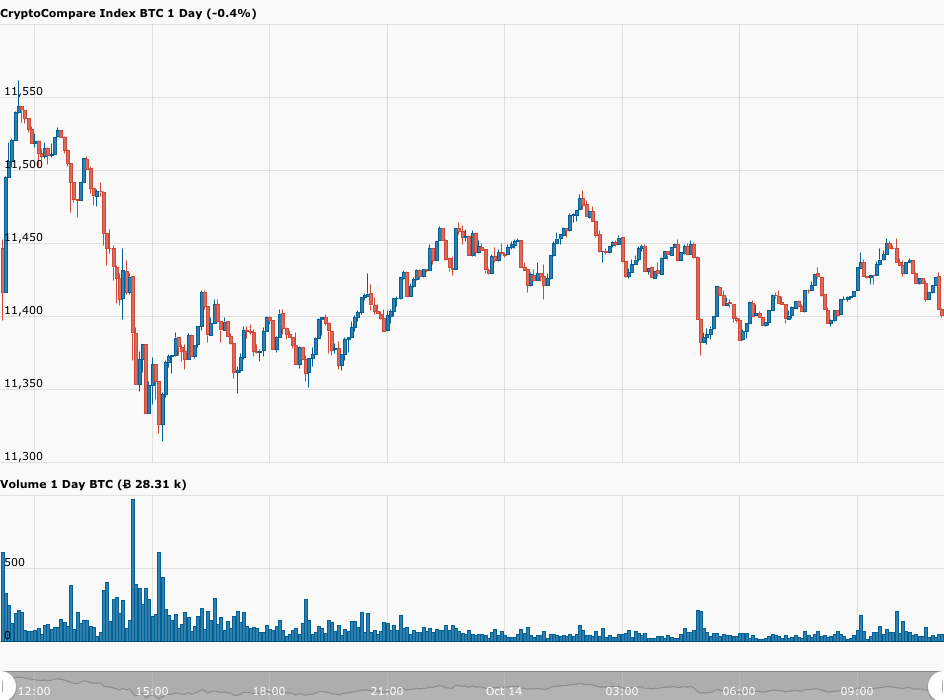On Tuesday (October 13), the U.S. stock market’s four-day winning streak came to an end. Bitcoin also fell yesterday, reaching an intraday low of $11,314 at one point. This article looks a closer look at the factors behind these declines.
Equities and cryptocurrencies are both examples of risk assets. Here is how Investopedia defines the term “risk asset”:
“A risk asset is any asset that carries a degree of risk. Risk asset generally refers to assets that have a significant degree of price volatility, such as equities, commodities, high-yield bonds, real estate, and currencies”.
And here is what Investopedia says about risk-free assets:
“A risk-free asset is one that has a certain future return—and virtually no possibility of loss. Debt obligations issued by the U.S. Department of the Treasury (bonds, notes, and especially Treasury bills) are considered to be risk-free because the “full faith and credit” of the U.S. government backs them. Because they are so safe, the return on risk-free assets is very close to the current interest rate.”
Before the COVID-19 pandemic started many people in the crypto community thought of Bitcoin as a non-correlated asset. Below is an example from May 2019:
In August 2019, prominent macroeconomist and crypto analyst Alex Krüger said that although Bitcoin was not a macro asset back then, if enough macro investors like Raoul Pal believe it is, then over time, it could become one:
Here is macroeconomist and crypto analyst Alex Krüger explaining in September 2019 why Bitcoin was not a “macro asset” at that time:
Then in March 2020, Krüger acknowledged that Bitcoin seemed to be trading like a risk-on asset:
And last Wednesday (October 7), Krüger pointed out that Bitcoin had over the past several months turned into a macro asset, meaning that it is influenced by macroeconomic and geopolitical factors in the same way that stock indexes are.
Yesterday (October 13), the three major U.S. stock indexes stumbled: The Dow Jones Industrial Average, the S&P 500, and the Nasdaq Composite dropped 0.6%, 0.6%, and 0.1% respectively.
As for Bitcoin, although it started the day around $11,662, by 14:15 UTC, it had dropped to $11,314, but managed to recover somewhat by the end of the day (UK time), reaching $11,442.
Currently (as of 10:13 UTC on October 14), Bitcoin is trading around $11,400, down 1.01% in the past 24-hour period:

So, what caused the declines in both U.S. stock indexes and Bitcoin?
Well, the two most likely culprits on this occasion were (1) the disappointing news from two major US pharmaceutical companies (Eli Lilly and Johnson & Johnson) regarding their COVID-19 therapeutic and vaccine trials and (2) the disappointing lack of news about further progress in the U.S. fiscal stimulus talks.
On Monday (October 12), STAT News reported that “the study of Johnson & Johnson’s Covid-19 vaccine has been paused due to an unexplained illness in a study participant.” Then, yesterday CNBC reported that the company’s CFO Joseph Wolk said in an interview on CNBC’s “Squawk Box” that this pause would give the independent Data and Safety Monitoring Board (DSMB) time to investigate this illness:
“We’re letting safety protocol follow proper procedure here… What it should also do is reassure the public that every scientific, medical and ethical standard is being applied here.”
Then, there was more bad news, this time from Eli Lilly. According to CNBC, “Eli Lilly’s phase three trial of its ACTIV-3 monoclonal antibody treatment for the coronavirus has been paused due to potential safety concerns.”
Spokeswoman Molly McCully told CNBC:
“Safety is of the utmost importance to Lilly. We are aware that, out of an abundance of caution, the ACTIV-3 independent data safety monitoring board (DSMB) has recommended a pause in enrollment… Lilly is supportive of the decision by the independent DSMB to cautiously ensure the safety of the patients participating in this study.”
As for the talks in Washington about the next major COVID-19 relief package, sadly, there is still deadlock. Although the Trump administration has made a $1.8 trillion proposal, House Speaker Nancy Pelosi says that this proposal does not provide sufficient relief and believes that the Trump Administration and the Senate Republicans to simply accept the $2.2 trillion package proposed by the House Democrats.
Meanwhile, Senate Republicans seem to believe that even the $1.8 trillion package proposed by the Trump administration is much too generous for their liking. According to CNBC, “Senate Majority Leader Mitch McConnell said that the Senate will vote on a limited stimulus bill later this month, which will be ‘targeted relief for American workers, including new funding’ for Paycheck Protection Program small business loans.”
Although many people are starting to think that it is appearing increasing unlikely that we will see consensus on a comprehensive COVID-19 relief package before Election Day (November 3), there is some hope that due to the shifting public opinion on this issue, Pelosi will come to the realization that if she does not accept some kind of relief proposal in the very near future, she could be blamed for the failure of these stimulus talks and the Democrats could suffer in the upcoming presidential election.
When you see CNN anchor Wolf Blitzer putting pressure Pelosi to stop playing hardball and make a deal to ease the suffering of millions of people in the U.S., you start to wonder if we are seeing the turning of the tide:
In fact, we are starting to see increasing pressure on Pelosi from within her own party to make a deal very soon with the Trump administration. Andrew Yang is one example of those people:
Featured Image by “SnapLaunch” via Pixabay.com
The views and opinions expressed by the author are for informational purposes only and do not constitute financial, investment, or other advice.








